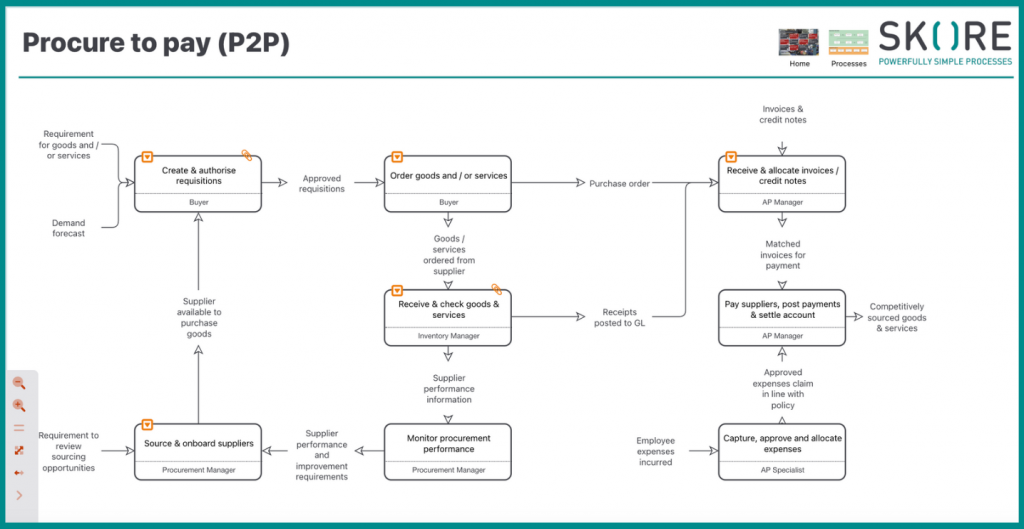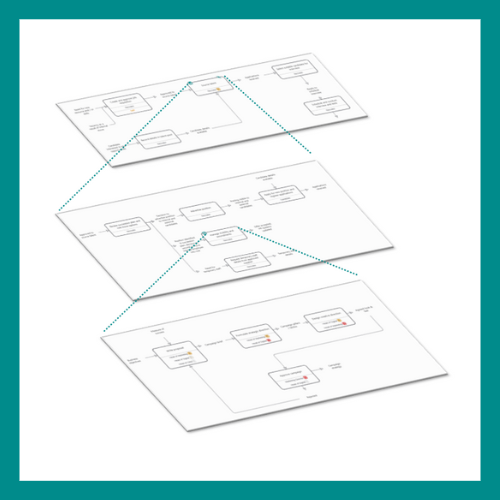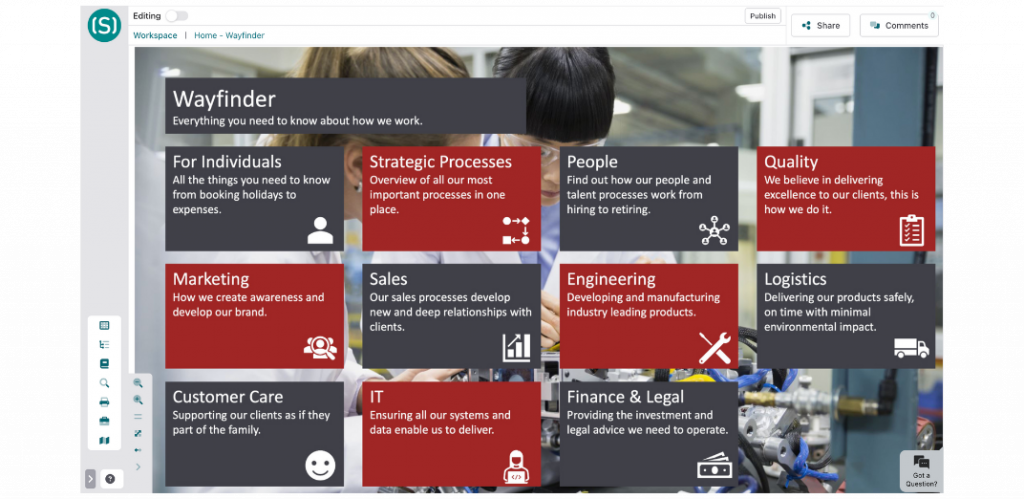4 reasons you should use Process Hierarchy when mapping processes
Do you understand the importance of process hierarchy and creating sub processes?
Mapping processes is a vital way of keeping your organisation healthy and ahead of the game. Any successful company should be doing it. But the method you use will make all the difference, changing this from a one off painful exercise to a way of working that brings instant and long term benefits for everyone.
You may have seen large 2 dimensional processes with tens, or even hundreds of steps included. They may have limited sub-processes, but most of the information is displayed in a single view. If printed out they span several pages carefully stuck together on the wall. Or if viewed on a computer screen they require both vertical and horizontal scrolling, constantly zooming in and out, to work out where in the process you are.
Some notations, such as UPN and IDEF0, have process hierarchy built in. It’s a natural part of the approach where processes are summarised at a high level and then individual steps are broken down into more and more detail. While this creates more diagrams it has a number of advantages making your process documentation more accessible to users, more effective for improvement, more efficient for stakeholders and much more connected across the organisation.
With modern software tools there’s really no need to keep creating large, complicated and difficult to use processes.
So here are 4 reasons why you should be using process hierarchy:
1. Process Hierarchy makes processes easier to read
Being able to summarise processes without losing the detail means that users can digest what’s on the page much faster. In many cases, individuals only need to understand a specific part of a process so being able to see the relevant part straight away makes life much easier.

What’s more, a summarised process is easier to display, in a readable format, on a single page or screen. Today, when we spend more time reading and consuming information on a computer screen, we are also limited to the size of that screen. So if you can fit a process on a standard computer screen, and make it readable, without zooming in and out of the text, it’s going to be easier to read.
With the right technology, users simply need to click through to see the next level of detail to get what they need and still understand the full context. Making it easier for them to read means you are going to have better engagement and collaboration from the people who really need to be accessing this information.
2. Process Hierarchy connects the right people to the right information faster
In addition to making processes easier to read, through breaking them down into digestible chunks, the process hierarchy means that colleagues only need to access the part of the process that’s relevant to them.

For example, executive management doesn’t need to know the details of how an invoice number is generated or who approves it. But they do need to know the key processes that deliver value to customers, the order they happen in and who owns them.
Similarly, a Finance Manager doesn’t need to know the individual line items on an invoice, but they do need to know the approval flow and the business rules that dictate who approves what.
The Finance Administrator needs to be very clear on how and when to create an invoice number and how to order the line items.
Each of these colleagues can enter the process hierarchy at the relevant level saving them time looking through large complicated flowcharts where only a small portion is relevant to them. This means your process map becomes a tool that can be presented to executive management for a high level overview and then drilled down into the detail when needed by any level of the organisation.
3. Process Hierarchy shows how key processes fit together
One of the most common problem areas, identified in process improvement projects, are handovers. Where information, or products, get handed over from one person, or team, to the next.
While we can try to reduce the number of handovers, across a whole organisation it’s impossible to eliminate them completely. Instead we need to know where the critical handovers happen and who owns each side of them. That way we can monitor and manage these interfaces.
Using process hierarchy to summarise all the processes into a single ‘Business on a Page’ view elevates this challenge to the executive level. All the organisation’s key processes can be displayed in one place, along with the key handovers.
This ‘architecture’ view of the organisation helps inform strategic conversations and aid decision making, especially when it comes to change and transformation.
What’s more, if the hierarchy is connected all the way down to the task level then senior management will have better insights into the impact of potential changes.

4. Process Hierarchy helps develop critical thinking
Mapping processes using hierarchy makes your efforts more effective because it forces stakeholders to think more critically about their processes. Simply describing a process step by step helps people to think about and challenge how it’s done.
But when stakeholders are also asked to summarise their process and then group low level activities together they go through a much deeper thought process.
It helps to reconcile different types of thinkers. Some people naturally think at a very high level while others think in detail. If your process document is only focused on detail then it’s harder for the high level thinkers to engage and follow and vice versa.
So collaboration becomes easier as you are able to use the hierarchy to address both needs and bring them together. Participants have more conversations about handovers as those handovers need to make sense at both the higher and lower levels. This forces teams to address issues that often go unnoticed and make decisions there and then.
Process hierarchy in UPN – choosing the right approach
Most standard process notations are designed to be flat 2 dimensional diagrams with all relevant information displayed in a single view. Notations such as BPMN allow for some sub-processes but these are generally limited in scope to include only activities carried out by the role, or system, associated with the parent box.
UPN, on the other hand, is designed with hierarchy as a key part. The intention is that processes can be summarised at a high level, then each step is deconstructed into more and more detail until the necessary information is captured.
Traditional tools for creating flowchart diagrams typically require the author to create multiple diagrams and manually link these together, which can be time consuming and prone to error and resource intensive maintenance over time. So when looking at building processes with hierarchy it’s important to find a tool that has this ability built in so that the software can manage the relationships between the parent and child diagrams in the hierarchy.
Conclusion
If you’re trying to influence change across the organisation and make a real impact with process improvement and process management then using process hierarchy is essential. It helps you create a holistic picture of all the processes in your organisation and how they connect.
But it’s just as important to select the right tool to help you. Not all process platforms support this type of mapping, or at least not easily. Notations such as UPN are hierarchical by nature so it’s best to choose a software that also supports hierarchy by default.
Doing so will help make your effort more effective, more efficient and more connected to the wider organisation.
If you’d like to explore this further please get in touch with a member of our team.
